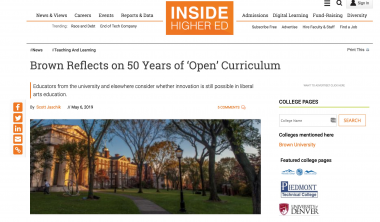The article by Scott Jaschik, editor and co-founder of Inside Higher Ed, stems from a recent gathering at Brown University attended by Felten and other experts in the field.
A May 6 Inside Higher Ed article focused on advances in the "open" curriculum approach during the past 50 years features insights from Peter Felten, assistant provost for teaching and learning and executive director of the Center for Engaged Learning.

"Only a few colleges have adopted similar open curricula, and some have criticized the curriculum for not sufficiently guiding students to make good educational decisions," Jaschik writes. "But many here see elements of the Brown philosophy — particularly in viewing undergraduates as active learners, able to make key decisions for themselves — as relevant for many colleges, including those with much more structure in the curriculum than Brown has."
Felten, joined by Sophia Abbott, a graduate apprentice in Elon's Master of Arts in Higher Education, led a discussion on viewing students as "partners" in learning. He noted that schools can still learn from Brown, even if their missions and student populations are different. "Context matters, but that doesn't mean you can't partner with your students," Felten said. "There is not a one-size-fits-all approach to this."
Read the entire article here.


